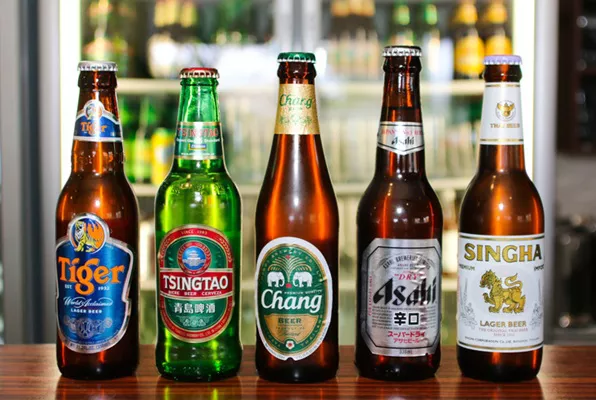In a rapidly evolving music landscape, will.i.am, frontman of the Black Eyed Peas, recently remarked, “Pop is the most competitive form of music there is. You are always fighting to be adopted and accepted by the masses, and it’s always shifting.” This sentiment resonates within the U.S. craft beer industry, where brands strive to attract a more diverse consumer base.
Industry experts note that as craft beer becomes increasingly segmented, national brands benefit from their widespread availability and resources to adapt to market trends. Madoff, a key player in the industry, emphasizes that “as this market grows and consumers have more options to choose from, brands need to be strategic in how they position themselves and cater their products to their target demographics.” He suggests that craft brewers can utilize platforms like Keychain to stay aligned with trends in product innovation and consumer preferences.
Ryan Toenies, a consultant at Circana in Chicago, highlights that national craft brands are leveraging their distributor networks to secure shelf space. Brands such as New Belgium’s Fat Tire and Voodoo Ranger are also expanding into single-serve formats in both traditional craft and flavored malt beverages (FMBs).
Recent Circana data for the 52 weeks ending September 15 reveals a 0.2% decline in the dollar trend for national craft brands, with regional craft brands faring even worse at a 5.9% decline in total U.S. multi-outlets. Toenies explains that regional brands are struggling to compete, losing shelf space amid shifting consumer preferences.
Despite these challenges, craft beer maintains a significant share of the market, with sales totaling $4.6 billion in Circana-tracked channels over the past year. Craft beer still holds a 10% share of the overall beer category, which saw a slight decline of 0.2% in dollar trends, while its three-year compound annual growth rate (CAGR) is down 3.5%.
Brian Sudano, CEO of S&D Insights LLC, describes the current state of the U.S. craft beer market as mixed. While overall market performance is declining, some larger brewers like New Belgium and Sierra Nevada are succeeding. Sudano notes a growing trend towards popular beer styles, such as hazy IPAs, and mentions that nostalgic styles like West Coast lagers are regaining popularity.
Regional craft brands, however, face significant hurdles. Sudano points out that acquisitions by Tilray have led major players like Molson Coors and ABI to exit the craft beer segment. While some strong local brewers are expanding their reach, many remain confined to limited markets.
Madoff emphasizes the advantage of regional brands in appealing to local consumers through niche marketing efforts. Many consumers prefer supporting local businesses, and regional breweries often leverage this sentiment by showcasing their community ties and ingredients.
As the craft beer segment grapples with shifting consumer trends, experts highlight the strategies brands are employing to adapt. Toenies notes that some craft brewers are exploring non-alcoholic options to stimulate growth, citing New Belgium’s success with a $24.5 million sales increase from its entry into the FMB market.
Sudano observes that reduced per capita alcohol consumption is influencing both the craft beer market and the broader alcohol industry. Trends toward moderation and alternative options, including cannabis and non-alcoholic beverages, are reshaping consumer habits.
In light of these changes, Madoff suggests that while some craft brands develop non-alcoholic offerings, others are focusing on marketing their unique brewing processes and community involvement. He asserts that technological advancements are essential for all players in the supply chain to keep pace with consumer trends. Ultimately, he believes that consumers are prioritizing experiences over products, prompting breweries to create engaging taproom experiences and community events.
Experts also emphasize the importance of sustainability in the craft beer sector. Madoff points out that many breweries are adopting eco-friendly practices, sourcing local ingredients, and minimizing their environmental impact, as evidenced by Keychain’s data on local supplier sourcing.
As the craft beer landscape continues to evolve, industry professionals are keenly observing which beer styles and packaging trends will shape the market. Sudano notes that IPAs dominate the craft beer space, accounting for 51% of craft beer dollars. He highlights a significant growth trend for 19-ounce single cans, while Circana reports a 2.1% dollar increase for IPA styles.
Toenies further underscores the positive impact of taprooms in connecting consumers with craft brewers and enhancing product sampling experiences. Madoff adds that these spaces help build brand loyalty and foster community engagement.
Looking ahead, Madoff predicts that non-alcoholic options will increasingly attract consumer interest as individuals seek healthier alternatives. He advises brands to adapt to these trends and consider the growing popularity of non-alcoholic offerings.
Sudano emphasizes the need for craft brewers to remain true to their core values amid the challenges of a declining overall beer market. Meanwhile, Toenies warns that inflation and economic factors are likely to slow growth in the beer category, impacting craft beer similarly.
In conclusion, as the U.S. craft beer market navigates these shifting dynamics, brands will need to innovate and adapt strategically to capture consumer interest and maintain their positions within an increasingly competitive landscape.
You Might Be Interested In:


